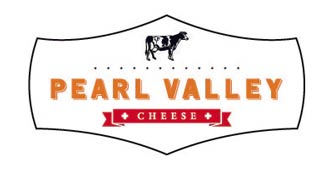Overview of the cheesemaking process
Making cheese is an art, as well as a science.
FROM THE FARM
At Pearl Valley Cheese, we start the process with only high quality milk. We purchase our milk from about 50 small family owned farms. On average, the farmers shipping milk to Pearl Valley milk between 30-40 cows and are located within a 50 mile radius of the plant.
 The milk is delivered on tanker trucks and is pumped into one of the silos in front of the plant for holding. The milk is then pumped from the silos through a separator and a pasteurizer. The separator allows us to remove some of the cream in the milk to make lower fat cheeses. Swiss cheese for example, is made with part-skim milk. The cream is sold to another factory that makes our Amish Country Roll Butter for us.
The milk is delivered on tanker trucks and is pumped into one of the silos in front of the plant for holding. The milk is then pumped from the silos through a separator and a pasteurizer. The separator allows us to remove some of the cream in the milk to make lower fat cheeses. Swiss cheese for example, is made with part-skim milk. The cream is sold to another factory that makes our Amish Country Roll Butter for us.
At Pearl Valley, we use what is called a High Temperature, Short Time (HTST) pasteurizer. The pasteurizer heats the milk up to at least 161°F and holds it there for at least 15 seconds, then cools it back down. This process kills any harmful bacteria in the milk and making it safe enough to drink. Or in our case, use to make cheese!
CURDS AND WHEY
The milk is then pumped into one of our four stainless steel vats called Double-“O”s. The vats each hold 35,000 lbs of milk which is enough to make about 3,500 lbs of cheese. As the cheese vats are filled with milk, the cheesemaker adds annatto coloring (if making a colored cheese), starter cultures, and rennet. 
The starter cultures are live bacteria that give different cheeses their characteristic flavors, textures, and in the case of Swiss cheese, holes. The rennet contains an enzyme that makes the milk proteins break down and form a gel-like form. This ‘gel’ is then cut with sharp knives into small pieces to form curds and whey. The curds contain most of the protein and fat from the milk and become the cheese. The whey is yellow colored liquid that contains a lot of the water from the milk, the milk sugars (called lactose), and some of the proteins. We sell our whey protein to a company that makes products for nutritional drinks, infant formula and milk replacer for calves.
CHEESE

For Colby type cheeses, the curds and whey are pumped to a long table with a drain in the center. The whey is drained off and salt it added. The curds are then moved to presses. The next morning the cheese is removed from the presses and packaged. Although Colby cheese can be sold right away, it is best to age it a couple weeks in the cooler for the flavor and texture to develop to perfection.

For Swiss type cheeses, the curds and whey are pumped directly from the vats to the presses. The whey is pumped off and the curds are pressed overnight to become long blocks of cheese. The next morning the cheese is cut into 200 pound blocks and placed in a salt water brine for a day. This is how the Swiss cheese gets its salt. The next day the cheese is moved packaged into boxes and placed in the cooler for cooling, then moved to a warm room for curing. During this time, the starter cultures grow and generate gas which makes the holes in the cheese. After that holes are developed, the cheese moved to a cooler for the cheese to be aged a little longer and then the blocks are cut and packaged.

